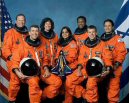
February 1, 2004
Shuttle workers, debris searchers
pause to remember Columbia
By MARCIA DUNN, Associated Press Aerospace Writer
 CAPE CANAVERAL, Fla.- One year after Columbia broke apart and fell in flaming streaks from the Texas sky, NASA workers who launched the shuttle and its seven astronauts and then gathered up the remains stood united in sorrow Sunday at the precise moment of destruction.
The first anniversary of the catastrophe was a time for everyone _ rocket engineers, debris searchers, school children, space enthusiasts, even football fans _ to pause and remember.
"One year ago, at this very hour, the unthinkable occurred," Kennedy Space Center's director, Jim Kennedy, told the crowd of a few hundred who gathered on a gray, drizzly morning at NASA's astronauts memorial.
Kennedy quietly recited the names of the Columbia astronauts, carved into the black granite monument behind him: Commander Rick Husband, co-pilot William McCool, Michael Anderson, David Brown, Kalpana Chawla, Laurel Clark and Israel's first astronaut, Ilan Ramon.
"They were our friends. They are our heroes. Their loss will not be in vain. We will come back bigger, better and stronger than ever before, and I can assure you that crew and their beloved families will never, ever be forgotten," Kennedy said.
Almost all of the mourners held a long-stemmed rose. After the brief outdoor ceremony, they tucked the red, yellow, peach and ivory-colored roses into the white fence surrounding the memorial.
Many wiped away tears.
The ceremony began at 9 a.m. EST, the instant NASA lost communication with Columbia over Texas on Feb. 1, 2003.
It ended at 9:16 a.m., the time the spacecraft should have landed on the Kennedy Space Center runway. By then, Columbia had shattered into tens of thousands of pieces that crashed down on Texas and Louisiana.
A piece of fuel-tank foam insulation had torn a hole in Columbia's left wing during the mid-January liftoff and allowed hot atmospheric gases to enter during atmospheric re-entry.
Knowing the astronauts well made the anniversary all the more painful for Arthur Willett, a shuttle recovery worker who spent three weeks in Texas picking up the pieces. "Even though working in this program day to day, you realize those things can happen _ until they do, it's hard to take that burden on," he said, gripping a rose.
Tributes also were held in many of the East Texas towns where the wreckage fell. The husbands of the two women who died aboard Columbia attended a memorial in Hemphill, in a packed Veterans of Foreign Wars hall. The memorial ended more than an hour later with a 21-gun salute.
Jean-Pierre Harrison said he wanted to thank the people who recovered the remains of his wife, Kalpana Chawla. "You are among the best America has to offer," he said.
Dr. Jon Clark, a NASA neurologist who was married to astronaut Laurel Clark, said going to East Texas was "like coming home."
"This is where the crew came home and this is where I wanted to be," Clark told the grieving crowd.
In Houston, where the Columbia astronauts lived and Mission Control is located, the biggest salute of all was saved for last _ the Super Bowl. The Columbia astronauts' families were invited to the football game, along with NASA's top officials.
The heartfelt remembrances stretched around the planet.
In northern Israel near the Sea of Galilee, Ramon's widow, four children and 80-year-old father gathered with friends and relatives at his grave and placed white cyclamen flowers and carnations on his tombstone.
Youngsters in Karnal, India, Chawla's hometown, recited prayers at the high school where she studied three decades earlier.
The anguish also reached beyond Earth. From the international space station, astronaut Michael Foale said not a day goes by that he doesn't think about his colleagues who died.
At Cape Canaveral, 18 students from the Fort Hall Indian Reservation in Idaho conducted a healing ceremony following the NASA observance. They had worked on a paint experiment that flew aboard Columbia, and spent the past year planning Sunday's tribute.
The youngsters from the Shoshone-Bannock tribes chanted traditional tribal songs to drumbeats to honor the dead. At about the same time in Syracuse, N.Y., students and teachers from Fowler High School, which had an ant experiment aboard Columbia, gathered in the snow for a moment of silence.
"Today we're one," said Ed Galindo, the Fort Hall science teacher who organized the student experiment and trip. "We're all brothers and sisters for one mission, to remember the crew and remember the lessons and go on."
The rain held off during the NASA ceremony and the dark clouds parted. But shortly afterward, as the Indian tribute was wrapping up, it poured as if in a spiritual renewal.
"This is the place where we leave the face of the Earth," said NASA's first American Indian astronaut John Herrington, who flew on shuttle Endeavour 1 1/2 months before Columbia's doomed mission. "But there's one group who didn't return _ and they're still on their journey."
___
On the Net:
NASA: http://www.nasa.gov/
The Associated Press contributed to this report.
Copyright © 2004 The Associated Press. All rights reserved. The information contained in the AP News report may not be published, broadcast, rewritten or redistributed without the prior written authority of The Associated Press.
AviationHistory.org shall not be liable for any errors or delays in the content, or for any actions taken in reliance thereon.
|














